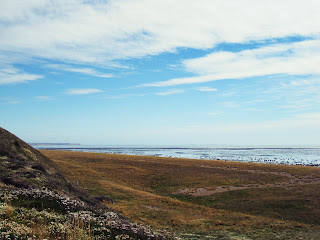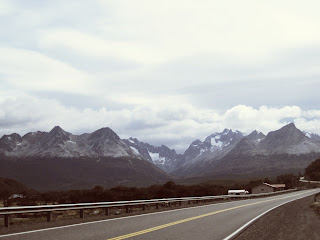Maxim Olegovich Morozov
The upstairs of the lodge looked down over the city to the port and in the west there were jagged mountains, some snow-covered. Across the Beagle Channel we could see the mountains that protected the harbor and they shown brightly in the sun. I was sitting with the Swede from Gothenberg at one of the stained wooden tables and we were drinking beer. A tall, thin guy with a long beard that I had seen around the campground sits down at the table beside ours. He leans over and asks in a thick accent where we are from.
“Where I am from does not exist,” he tells us.
“What are you?”
“I am Russian.”
“But Russia exists,” the Swede says.
“Where I am from does not exist. I am from Tashkent.”
“That is Uzbekistan. You are an Uzbek.”
“I am Russian," he says. "The muslims have taken Tashkent. But it was Russia and in the years ‘86 to’88 Tashkent was the greatest city in the world.”
“Where do you live now,” I ask him.
“I live in a tent on that hill over there.”
“We are neighbors then," I say. "I live there too.”
“How old are you?” the Russian asks me.
“How old do you think.”
“I think 44.”
I smiled. “How old are you?”
“You guess.”
“29.”
“You are right. But I will not be 29 anymore.”
“It will be your birthday?”
“No, not really.”
The Swede laughs. “How will you turn 30 then?”
“You only have one birthday. Think about it.”
“What are you doing here?” asks the Swede.
“I am looking for a wife.”
“Here in Ushuaia?”
“I am looking here, but also other places. I am looking for two things. She must not live in a city.”
“What’s the other thing?”
“She must be a virgin.”
“How will you know that?”
“I will know.”
“How will you be sure? Sometimes you cannot be completely sure.”
“I will take her when she is thirteen.”
The Swede laughs.
“I will grow her up.”
“There is only one thing better than a thirteen year old girl,” says the Russian.
“What’s that?”
“A twelve year old girl.”
The Swede is still laughing.
“I will take her to live in the forest in Siberia. We will have nine children. That is the number Russian women gave birth to a century before. She will give birth to them in the home. Hospitals rush the birth and make women not want more children. Before only prostitutes gave birth in hospitals.”
The Russian goes on to tell us that he is a priest but he is learning to become a warrior. He tells me that he thinks that I am mostly a warrior. The Swede is neither priest nor warrior. Vlad the Impaler was also a warrior, he says. He was in constant war with everyone and slept outside the royal palace on the grass. He won every battle until they ambushed him and cut his throat, cut off his head and drank wine from his warm skull. I think it’s a compliment to be a warrior, but I don’t question him further.
The Russian has a bag next to him and as he’s talking he takes two long purple potatoes, three jalapeno peppers, and a cup of yogurt and arranges them on a napkin.
“I eat uncooked vegetables,” he says. “I do not eat meat and I do not eat mushrooms. Once I lived on uncooked corn for 3 months. But I lost 28 kilos. I had to stop and to eat dairy. It frightened me. I was very scared. I eat dairy now but slowly I will eat less.”
The Russian takes a clove of garlic from the bag.
“Garlic is a cure, it is not a food. I can clean the lungs by chewing and by breathing. If I am cut I rub the garlic on the wound to clean it. If I begin to be sick I will eat it. It is not a food.”
He produces an onion from the bag and continues, “The cheapest source of vitamin C is onions. That is how we survive, we Russians. Onions. That is not a food too. If you use everyday it does not make sense.”
The Russian holds up a green jalapeno pepper. “This I use to expand my diaphragm. It is not a food too. I like the experience when you eat a pepper and you just explode. You have been a normal guy, and now you don’t know what to do,” he smiles broadly. “Tomorrow I will not eat on the bus. It is 14 hours. If I eat the immune system will be needed to digest the badness in the food and it will not protect me from the germs. If you could practice my breathing exercises you would not need to eat so much. But you must have a pure conscience to practice my breathing exercises. Without a pure conscience you would die.”
The Russian stops talking to eat. The Swede and I are quiet. A strong wind is blowing through the trees from the southwest and I see storm clouds covering the mountains beyond the channel. It's raining hard in the mountains and soon the rain is at the campground, pounding against the windows. The Russian has finished eating his two potatoes and his peppers and yogurt. He stands and addresses us.
“I have to go now,” the Russian says. “But do not forget this. If a good man dies you put a stone. But if a great man dies you must build a hill.”
The Russian turns and pushes through the door of the lodge and goes down the stairs. The Swede and I watch him walk slowly up the hill in the heavy rain.



















































